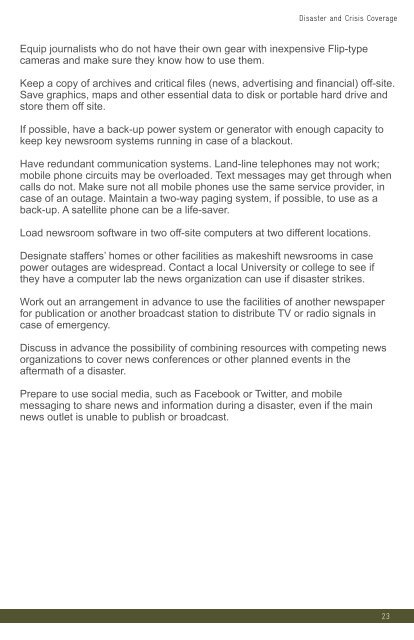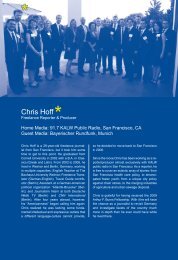Disaster and Crisis Coverage - International News Safety Institute
Disaster and Crisis Coverage - International News Safety Institute
Disaster and Crisis Coverage - International News Safety Institute
Create successful ePaper yourself
Turn your PDF publications into a flip-book with our unique Google optimized e-Paper software.
<strong>Disaster</strong> <strong>and</strong> <strong>Crisis</strong> <strong>Coverage</strong><br />
Equip journalists who do not have their own gear with inexpensive Flip-type<br />
cameras <strong>and</strong> make sure they know how to use them.<br />
Keep a copy of archives <strong>and</strong> critical files (news, advertising <strong>and</strong> financial) off-site.<br />
Save graphics, maps <strong>and</strong> other essential data to disk or portable hard drive <strong>and</strong><br />
store them off site.<br />
If possible, have a back-up power system or generator with enough capacity to<br />
keep key newsroom systems running in case of a blackout.<br />
Have redundant communication systems. L<strong>and</strong>-line telephones may not work;<br />
mobile phone circuits may be overloaded. Text messages may get through when<br />
calls do not. Make sure not all mobile phones use the same service provider, in<br />
case of an outage. Maintain a two-way paging system, if possible, to use as a<br />
back-up. A satellite phone can be a life-saver.<br />
Load newsroom software in two off-site computers at two different locations.<br />
Designate staffers’ homes or other facilities as makeshift newsrooms in case<br />
power outages are widespread. Contact a local University or college to see if<br />
they have a computer lab the news organization can use if disaster strikes.<br />
Work out an arrangement in advance to use the facilities of another newspaper<br />
for publication or another broadcast station to distribute TV or radio signals in<br />
case of emergency.<br />
Discuss in advance the possibility of combining resources with competing news<br />
organizations to cover news conferences or other planned events in the<br />
aftermath of a disaster.<br />
Prepare to use social media, such as Facebook or Twitter, <strong>and</strong> mobile<br />
messaging to share news <strong>and</strong> information during a disaster, even if the main<br />
news outlet is unable to publish or broadcast.<br />
23
















